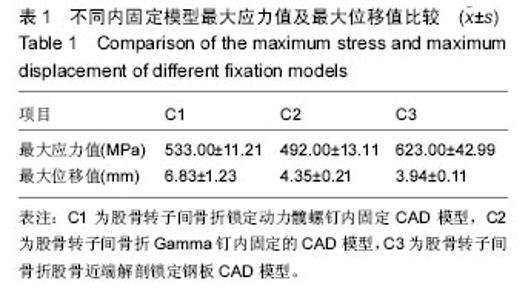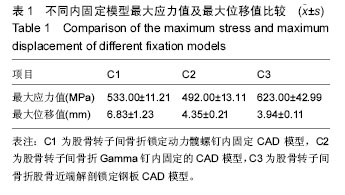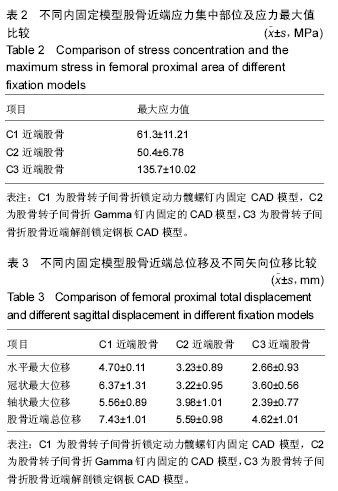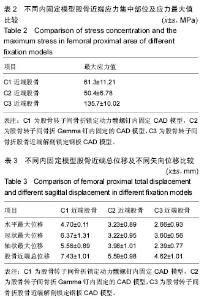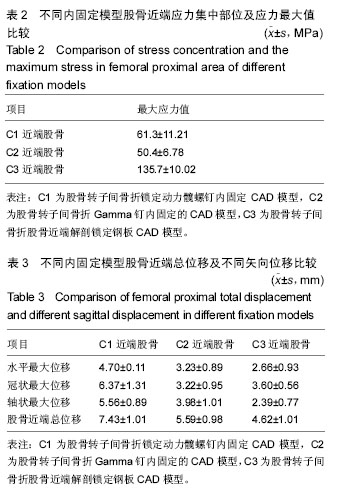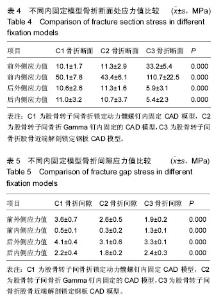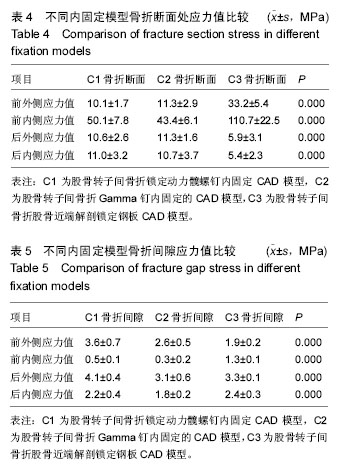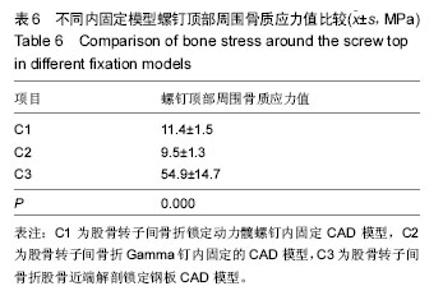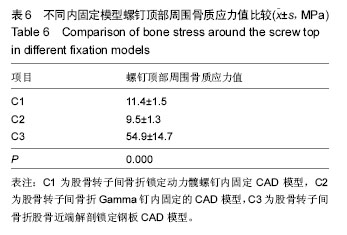| [1] 龚宪生,王超.一种新型无柄股骨假体的设计[J].研究工程设计学报,2005,12(5):288-293.
[2] 李伟,陆皓,孙康.复合材料与金属材料髋关节假体应力分布的三维有限元分析[J].生物骨科材料与临床研究, 2005, 2(3):1-4.
[3] 郑锋,林海滨.人骨三维有限元分析的研究进展[J].医学综述,2011,17(11):1689-1691.
[4] 李雪峰,姜为民. 4种内固定方式治疗股骨转子间骨折的疗效对比[J].临床骨科杂志,2009,12(3):302-304.
[5] Kcyak JH, Kaneko TS, Tehranzadeh J, et al. Predicting Proximal Femoral Strength Using Structurai Engineering Models. Clin Orthop Relat Res. 2005; 437: 219-228.
[6] 张美超,黄文华,王柏川,等.应用有限方法评价颈前路蝶型钢板的力学性能[J].第一军医大学学报,2001,21(10): 740-742
[7] 韦兴,侯树勋,张美超,等.腰椎滑脱短节段固定器的初步有限元分析[J].中国脊柱脊髓杂志,2002,12(5):363-365.
[8] 黄少校. 内固定治疗股骨粗隆间骨折患者的研究进展[J]. 齐齐哈尔医学院报.2014,35(15):2293-2295.
[9] 邱利杰,李开南,李鹏.股骨粗隆间骨折的治疗进展[J].现代临床医学, 2011,31(4):457.
[10] 蒋梁华,李晓林.股骨粗隆间骨折内固定治疗的研究进展[J].实用骨科杂志,2012,18(2):143.
[11] 向文东,王清,毛吉刚,等.DHS 和PEN 在老年股骨粗隆间骨折中的治疗选择[J].岭南现代临床外科,2010,10(2): 111-113.
[12] 李意.股骨粗隆间骨折内固定手术治疗的研究进展[J].重庆医学,2013,42(10):1172.
[13] 周毅,李兴海,陈玉楼,等.动力髁螺钉治疗不稳定型股骨粗隆间骨折[J].中国矫形外科杂志,2012,22(11): 1700-1703.
[14] 周生瑞,苗胜,石玉刚.动力髁螺钉(DCS)治疗老年股骨粗隆间骨折的37例疗效观察[J]. 哈尔滨医药,2010,30(5): 15-17.
[15] 罗晓中,吴刚,谭伦,等.微创锁定板技术治疗股骨转子间骨折的临床研究[J].实用骨科杂志,2010,16(9): 651-653.
[16] 彭维波,农林,韦仕战,等.Gamma钉与动力髋螺钉治疗股骨转子间骨折的Meta分析[J].中国组织工程研究与临床康复,2011,15(43):8108-8111.
[17] 冯建武. 股骨近端解剖锁定钢板治疗老年股骨粗隆间骨折[J].实用临床医药杂志,2012, 16(3):71-72.
[18] 费青,吕南千,马俊峰,等. 股骨近端髓内钉INTERTAN治疗老年股骨转子间骨折[J].中国矫形外科杂志,2011, 19(20):1749-1750.
[19] 蒋洪涛.伽马钉治疗股骨粗隆间骨折47例[J].中外健康文摘,2010,7(28):192-193.
[20] 茅泳涛,徐炜,谢宗刚,等.髓内钉InterTan与锁定钢板置入固定股骨转子间骨折的随访[J].中国组织工程研究,2012, 16(9): 1564-1567.
[21] 黄昌富,周忠,付佳拥.DHS和PFN治疗老年骨质疏松性股骨粗隆间骨折疗效分析[J]. 中华保健医学杂志,2010, 12(1):38.
[22] 谭家昌,徐鸿育,杨有猛,等.螺孔型股骨近端解剖钢板与动力髋螺钉治疗老年股骨转子间骨折的比较研究[J].中国矫形外科杂志,2010,16(6):461-462.
[23] 谭家昌,徐鸿育,杨有猛,等.股骨近端解剖钢板治疗粗隆间骨折失败原因分析[J].实用骨科杂志,2010,14(1):11-12.
[24] 黄叶建,韩成湘.动力加压髋螺钉(DHS)内固定治疗股骨粗隆间骨折的临床疗效评价[J].当代医学,2012,33(2) : 48.
[25] 杨建中,贾子超,陈光.股骨粗隆间骨折的治疗进展[J].滨州医学院学报,2010,12(2):153.
[26] 王鹏建,张超,阮狄克,等.股骨粗隆间骨折的外科治疗策略及疗效分析[J].中国骨与关节损伤杂志,2010,8(3):257.
[27] 胡晓东,肖信约,陆家勇.PFN-A治疗老年不稳定股骨粗隆间骨折的手术体会[J].中国骨与关节损伤杂志, 2011,5(2): 786.
[28] 陈利春,张秉文,卢勇明.PFNA 治疗股骨粗隆间骨折分析[J].中国骨与关节杂志,2012,1(6):623-625.
[29] 孙俭波,杨爱文,王树明,等.Gamma 钉治疗股骨粗隆间骨折的疗效分析[J].山西医药杂志,2010,34 2):581.
[30] 蒋梁华,李晓林. 股骨粗隆间骨折内固定治疗的研究进展[J].实用骨科杂志,2012,18(2):143-146.
[31] 方国芳,林荔军,于博,等.不同状态下股骨的应力分布及临床应用[J].中国组织工程研究,2012,16(17): 3045-3047.
[32] 黄诸侯,李俊,陈日齐,等. 跟骨三维有限元模型的建立及其骨折发生机制[J].中国骨伤,2012,25(2):97-101.
[33] 徐灵军,朱海波,张银网,等.人工髋关节活体有限元建模及力学分析[J].中国组织工程研究,2012,16(26): 4770-4775.
[34] Brolin K, Halldin P.Development of a finite element model of the upper cervical spine and a parameter study of ligament characteristics.Spine. 2004;29(4): 376-385.
[35] Keyak JH, Rossi SA, Jones KA, et al.Prediction of fracture location in the proximal femur using finite element models.Med Eng Phys.2001;23(9):657-664.
[36] Seipel R C, Pintar FA, Yognanadan N, et al. Biomechanics of calcaneal fractures: a model for the motor vehicle. Clin Orthop. 2001;388: 218-224.
[37] Culemann U, Pohlemann T, Hufneu T, et al. 3-dimensional movement analysis after internal fixation of pelvic ring fractures. A computer simulation. Unfallchirurg. 2000;103(11): 965-971.
[38] Byrne AM, Kearns SR, Morris S, et al. "S" Quattro external fixation for complex intra-articular thumb fractures. Orthop Surg. 2008;16(2):170-174.
[39] 孟立民,苏啸天,张银光,等.微型外固定支架和克氏针治疗Bennett骨折的三维有限元分析[J].中国组织工程研究, 2012,16(9):1626-1630.
[40] Chan KC,Gill GS.Cemented hemiarthroplasties for elderly patients with intertrochanteric fractures. Clin Orthop. 2000;317(2):206-215.
[41] 王刚,任高宏,王华民,等.锁定加压钢板(LCP)治疗桡骨远端不稳定骨折初步报告[J].中国创伤骨科杂志,2003,5(2): 99-102. |
